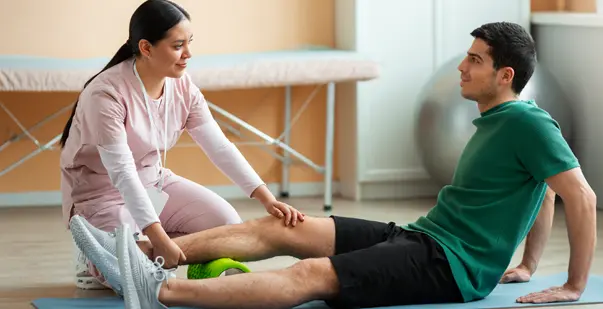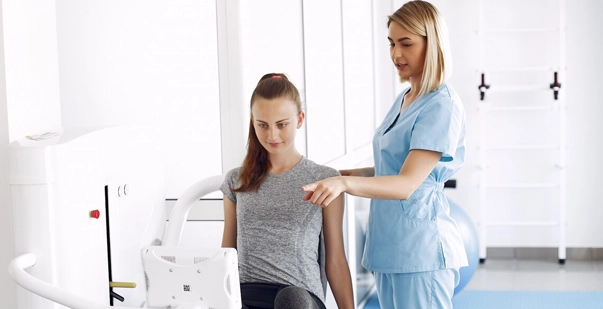Every October, National Physical Therapy (PT) Month recognizes the important work PTs and physical therapist assistants (PTAs) do to help people recover strength, mobility, and independence. Your care often determines whether patients return to their daily routines with confidence or face avoidable setbacks.
Courses on balance training, fall prevention, and pain management keep your methods current and effective and Continuing Education (CE) helps you build on .
In this guide, we’ll look at CE skills that are worth your time. You’ll see how ongoing learning supports physical therapy professional development. It keeps your care effective and closely aligned with what patients need today.
Read More: What Is Professional Physical Therapy?
Why Physical Therapists Need New Skills to Improve Care
Physical therapy goes far beyond helping people recover from surgery or sports injuries. As a PT, you also help patients manage long-term conditions, guide older adults through safe movement, and lower the chance of hospital readmissions. To keep doing this well, you need to keep building your skills so they match the needs of patients today and the standards of modern healthcare.
Rising Demand and Shifting Needs
More people are living longer, often with conditions like diabetes and heart disease. That means you’ll see patients who need therapy for the long term, not just short rehab plans. At the same time, value-based care links reimbursement to how well you help patients recover safely. You’re expected to do more than restore function, you also need to prevent setbacks and keep costs manageable.
New Pressures on Practice
You can’t rely only on what you learned years ago. The profession now asks you to adapt quickly to new challenges:
Technology: Telehealth and wearable devices are part of patient care. You need to know how to use them effectively.
Patient Expectations: Patients want faster progress and plans that feel tailored to them.
Regulatory Rules: Accurate documentation, Health Insurance Portability and Accountability Act (HIPAA) standards, and changing licensure requirements affect your daily work.
These challenges make continuing education for physical therapists vital for patient care and safety.
Read More: Differences Between Occupational Therapy And Physical Therapy
Why Lifelong Learning Drives Safety and Outcomes
Your patients depend on you to stay current. When you know the latest fall-prevention techniques, pain management strategies, or mobility aids, you lower their risks and give them more independence. National Physical Therapy Month highlights how continuing education keeps your care effective, evidence-based, and aligned with what patients need most today.
Read More: The Importance of Continuing Education in Physical Therapy: Why Lifelong Learning Matters
CE Improves Your Daily Practice
CEU courses in physical therapy help you make better decisions in the clinic. They show you how to use safer interventions and adjust care. By doing this, you avoid old habits and rely on methods that are tested and evidence-based.
The Skills You Strengthen
CE programs focus on physical therapy patient safety skills that directly impact patient outcomes:
Assessment: Learn advanced evaluation methods to spot movement problems and track progress.
Manual Therapy: Improve hands-on techniques to reduce pain, restore mobility, and support healing.
Technology Integration: Use motion analysis, wearable sensors, and tele-rehab tools to guide therapy.
Safety: Stay current with fall-prevention strategies, infection control, and safe exercise plans.
Communication: Build trust with clear, patient-centered conversations and better teamwork across care providers.
Choosing the Right Skills for Your Role
Every therapist’s priorities are different. If you work in orthopedics, manual therapy may be your focus. If you work in neuro-rehab, advanced assessment and safety might matter more. CE gives you the freedom to tailor learning to your patients and practice setting, so your growth always connects to real-world care.
CE Skills That Directly Enhance Patient Recovery
When you take continuing education as a physical therapist, you’re not just collecting credits. You’re learning skills that directly help your patients recover better and stay safe during treatment. The right courses can sharpen how you work every day. Here are the areas that can make your practice stronger:
Improving Accuracy in Patient Assessment and Diagnosis
Recovery begins with knowing what’s really going on. Continuing education courses show you how to analyze movement, apply pain science, and use reliable tools to measure strength, mobility, and function. When your assessments are precise, you can plan treatments that fit each patient’s needs—without falling back on guesswork.
Integrating the Latest Research Into Everyday Treatment
Physical therapy changes quickly, and older methods can slow progress. CE keeps you up to date with the latest research and shows you how to apply it in real cases, whether it’s new load management strategies for tendinopathy or revised rehab protocols for stroke recovery. When you build this habit of using evidence in practice, you improve both safety and consistency in patient outcomes.
Improving Recovery Through Technology and Innovation
Rehab today goes beyond the clinic walls. You can use telehealth to run remote sessions, wearable sensors to track progress, and apps to help patients stay on top of home exercises. CE also introduces you to newer tools like virtual reality and AI-based platforms that make care more personalized and engaging. Training in these technologies helps you meet patients where they are, both in person and online.
Restoring Function With Advanced Manual Therapy Techniques
Hands-on therapy remains a core part of recovery. New CE programs teach advanced mobilization, soft tissue methods, and joint manipulation techniques that reduce pain and restore function. When you combine these manual skills with exercise and patient education, you not only improve recovery speed but also help patients feel more confident in their daily lives.
Read More: 7 Benefits of Physical Therapy Training for HealthCare Providers
CE Skills for Patient Safety: How to Reduce Risk
Keeping patients safe goes beyond giving the right treatment. You also need to spot risks early and take steps to prevent them. Continuing education (CE) helps you build these skills so recovery is not only faster but also safer. Here are three ways CE training strengthens patient safety.
Fall Prevention Through Targeted Programs
Falls are one of the biggest risks for older adults, and they often lead to long hospital stays. Through CEU courses for physical therapy, gait training, and strength work, you learn how to create programs that prevent falls. With these approaches, you can reduce the chance of accidents and help patients feel steady in their daily movements.
Screening for Red Flags and Comorbidities
Sometimes pain or mobility issues are not just musculoskeletal. CE training shows you how to look for “red flags". These include unexplained weight loss, neurological changes, or systemic symptoms. You also learn how to adjust treatment when a patient has conditions like diabetes, cardiovascular disease, or osteoporosis. Even basic exercises may need changes. Continuing education shows you how to make those changes in a safe way.
Safety Protocols for High-Risk Populations
When working with older adults or people with complex health conditions, safety demands extra care. CE gives you clear, evidence-based protocols to follow. These include checking vitals during sessions, knowing when to pause or refer, and using assistive devices properly. With these practices, you can lower complications and guide patients through recovery with confidence.
How PT Practices Build a Culture of Safety and Recovery
Physical therapy is about more than restoring movement. It also builds a system that keeps you safe during recovery and reduces the chance of setbacks. During National Physical Therapy Month, it’s a reminder that this system doesn’t appear on its own. PT teams create it through daily choices, training, and the way they involve you in the process.
Learning From Each Other
In a strong PT practice, therapists don’t work in isolation. Senior staff mentor new members, and teams hold peer learning sessions to share knowledge quickly. This keeps best practices, like safe handling or spotting early warning signs, alive in the day-to-day work, not hidden away in a manual.
Using Data and Patient Feedback
Recovery is something you can measure. Therapists track progress with clear indicators like range of motion, balance, and pain levels. If results slow down, they adjust right away. Your feedback also matters. When you explain what feels hard or what you struggle with at home, therapists can refine your plan to make it both safer and more effective.
Educating Patients as Partners
When your PT explains exercises, risks, and home care routines, they’re giving you the tools to take charge. If you understand why a stretch matters or how to protect yourself from reinjury, you’re more likely to stay on track and keep the progress you’ve worked for.
Read More: Advanced Techniques in Physical Therapy Continuing Education Courses
Your Action Plan for Better PT Outcomes
National Physical Therapy Month is a reminder that learning doesn’t stop after you get your license. When you build on your skills, whether in assessment, manual therapy, new rehab technology, or fall prevention, you give patients more than mobility. You give them safer recoveries and the confidence to get back to daily life.
So what’s the next step? If you’re a therapist, choose one area to sharpen each year. You might explore balance training, pain science, or even digital rehab tools. If you want to build a career in physical therapy, choose accredited programs and resources from trusted organizations. This helps you stay current, and it also gives your patients the best chance at steady, lasting recovery.








.webp)


.webp)









